Effects of Vegetation Cover on Community Structure of Rodents Based on Long Time Series from Dongting Lake, China
Simple Summary
Abstract
1. Introduction
2. Study Area and Method
2.1. Study Area and Survey of Rodent Communities
2.2. Vegetation Cover Monitoring Based on Remote Sensing
2.2.1. Remote Sensing Data Acquisition and Processing
2.2.2. Vegetation Cover Analysis
2.3. Data Statistical
3. Results and Analysis
3.1. Characterization of Rodent Community Structure in Dongting Lake
3.1.1. Spatial and Temporal Dynamics of Capture Rates
3.1.2. Fatness Characterization of Rodent Community in Dongting Lake
3.2. Characteristics of Vegetation Cover Changes in Dongting Lake
3.2.1. Interannual Spatial and Temporal Characteristics of Vegetation Cover
3.2.2. Seasonal Characteristics of Vegetation Cover
3.3. Relationship Between Vegetation Cover and Population Density
3.4. Relationship Between Vegetation Cover and Fatness
4. Discussion
5. Conclusions
Supplementary Materials
Author Contributions
Funding
Institutional Review Board Statement
Informed Consent Statement
Data Availability Statement
Conflicts of Interest
References
- Lacher, T.E., Jr.; Davidson, A.D.; Fleming, T.H.; Gómez-Ruiz, E.P.; McCracken, G.F.; Owen-Smith, N.; Peres, C.A.; Vander Wall, S.B. The functional roles of mammals in ecosystems. J. Mammal. 2019, 100, 942–964. [Google Scholar] [CrossRef]
- Eccard, J.A.; Walther, R.B.; Milton, S.J. How livestock grazing affects vegetation structures and small mammal distribution in the semi-arid Karoo. J. Arid. Environ. 2000, 46, 103–106. [Google Scholar] [CrossRef]
- Christian, D.P. Vegetative Cover, Water Resources, and Microdistributional Patterns in a Desert Rodent Community. J. Anim. Ecol. 1980, 49, 807–816. [Google Scholar] [CrossRef]
- Imakando, C.I.; Fernández-Grandon, G.M.; Singleton, G.R.; Belmain, S.R. Vegetation cover and food availability shapes the foraging activity of rodent pests in and around maize fields. Agric. Ecosyst. Environ. 2023, 347, 108363. [Google Scholar] [CrossRef]
- Gao, L.; Wang, X.; Johnson, B.A.; Tian, Q.; Wang, Y.; Verrelst, J.; Mu, X.; Gu, X. Remote sensing algorithms for estimation of fractional vegetation cover using pure vegetation index values: A review. ISPRS J. Photogramm. Remote Sens. 2020, 159, 364–377. [Google Scholar] [CrossRef] [PubMed]
- Andreo, V.; Belgiu, M.; Hoyos, D.B.; Osei, F.; Provensal, C.; Stein, A. Rodents and satellites: Predicting mice abundance and distribution with Sentinel-2 data. Ecol. Inform. 2019, 51, 157–167. [Google Scholar] [CrossRef]
- Chidodo, D.J.; Kimaro, D.N.; Hieronimo, P.; Makundi, R.H.; Isabirye, M.; Leirs, H.; Massawe, A.W.; Mdangi, M.E.; Kifumba, D.; Mulungu, L.S. Application of normalized difference vegetation index (NDVI) to forecast rodent population abundance in smallholder agro-ecosystems in semi-arid areas in Tanzania. Mammalia 2020, 84, 136–143. [Google Scholar] [CrossRef]
- Cockle, K.L.; Richardson, J.S. Do riparian buffer strips mitigate the impacts of clearcutting on small mammals? Biol. Conserv. 2003, 113, 133–140. [Google Scholar] [CrossRef]
- Zhang, M.; Wang, Y.; Li, B.; Feng, Z.; Zhao, Y.; Xu, Z. Synergistic succession of the small mammal community and herbaceous vegetation after reconverting farmland to seasonally flooded wetlands in the Dongting Lake Region, China. Mammal Study 2018, 43, 229–243. [Google Scholar] [CrossRef]
- Zhang, M.; Wang, Y.; Li, B.; Guo, C.; Huang, G.; Shen, G.; Zhou, X. Small mammal community succession on the beach of Dongting Lake, China after the Three Gorges Project. Integr. Zool. 2014, 9, 294–308. [Google Scholar] [CrossRef]
- Yong, W.; Mei-Wen, Z.; Bo, L.I.; Kai-Rong, W. Rodent community structure and succession in different ecotypic areas in Dongting Lake region. J. Ecol. Rural. Environ. 2003, 19, 13–17. [Google Scholar]
- Xu, Z.; Zhao, Y.; Li, B.; Zhang, M.; Shen, G.; Wang, Y. Habitat evaluation for outbreak of Yangtze voles (Microtus fortis) and management implications. Integr. Zool. 2015, 10, 267–281. [Google Scholar] [CrossRef]
- Zheng, J.-M.; Wang, L.-Y.; Li, S.-Y.; Zhou, J.-X.; Sun, Q.-X. Relationship between community type of wetland plants and site elevation on sandbars of the East Dongting Lake, China. For. Stud. China 2009, 11, 44–48. [Google Scholar] [CrossRef]
- Jianing, H.; Chen, Z.; Guiyan, Y.; Zhenggang, X.; Meiwen, Z.; Yong, W.; Bo, L.; Xunjun, Z.; Huanan, H. The reproductive status of Apodemus agrarius populations inhabiting the lake beach in Lake Dongting area after Three Gorges Project. J. Lake Sci. 2023, 35, 2101–2110. [Google Scholar]
- Hu, J.-Y.; Xie, Y.-H.; Tang, Y.; Li, F.; Zou, Y.-A. Changes of Vegetation Distribution in the East Dongting Lake After the Operation of the Three Gorges Dam, China. Front. Plant Sci. 2018, 9, 582. [Google Scholar] [CrossRef] [PubMed]
- Liu, Y.; Li, J.; Yan, D.; Chen, L.; Li, M.; Luan, Z. Typical vegetation dynamics and hydrological changes of Dongting Lake wetland from 1985 to 2020. Ecohydrol. Hydrobiol. 2024, 24, 910–919. [Google Scholar] [CrossRef]
- Zunlong, F.; Yong, W.; Senyun, D.; Jun, W. Fatness degree of striped hairy-footed hamster (Phodopus sungorus) in Inner Mongolia, China. Chin. J. Ecol. 2013, 32, 3250–3254. [Google Scholar]
- Dwyer, J.; Schmidt, G. The MODIS Reprojection Tool. In Earth Science Satellite Remote Sensing: Vol. 2: Data, Computational Processing, and Tools; Qu, J.J., Gao, W., Kafatos, M., Murphy, R.E., Salomonson, V.V., Eds.; Springer Berlin Heidelberg: Berlin/Heidelberg, Germany, 2006; pp. 162–177. [Google Scholar] [CrossRef]
- Du Plessis, W.P. Linear regression relationships between NDVI, vegetation and rainfall in Etosha National Park, Namibia. J. Arid. Environ. 1999, 42, 235–260. [Google Scholar] [CrossRef]
- Gitelson, A.A.; Kaufman, Y.J.; Stark, R.; Rundquist, D. Novel algorithms for remote estimation of vegetation fraction. Remote Sens. Environ. 2002, 80, 76–87. [Google Scholar] [CrossRef]
- Miaomiao, L.; Bingfang, W.; Changzhen, Y.; Weifeng, Z. Estimation of Vegetation Fraction in the Upper Basin of Miyun Reservoir by Remote Sensing. Resour. Sci. 2004, 26, 153–159. [Google Scholar]
- You, A.; Zhang, X. Impacts of climate change and human activities on vegetation cover changes in the Fen River headwaters based on long time series data. J. Comb. Math. Comb. Comput. 2025, 127, 6621–6640. [Google Scholar]
- Zhenggang, X.; Yunlin, Z.; Bo, L.; Meiwen, Z.; Yong, W. Forecast of Microtus fortis disaster in Dongting Lake region of China. Chin. J. Ecol. 2013, 32, 2830–2836. [Google Scholar]
- An, C.; Fang, H.; Zhang, L.; Su, X.; Fu, X.; Huang, H.Q.; Parker, G.; Hassan, M.A.; Meghani, N.A.; Anders, A.M.; et al. Poyang and Dongting Lakes, Yangtze River: Tributary lakes blocked by main-stem aggradation. Proc. Natl. Acad. Sci. USA 2022, 119, e2101384119. [Google Scholar] [CrossRef] [PubMed]
- Meiwen, Z.; Bo, L.; Yong, W. Analysis on Causes of Population Outbreak of Microtus fortis in Dongting Lake Region in 2007. Res. Agric. Mod. 2007, 28, 601–605. [Google Scholar]
- Zhongyu, Y.; Meiwen, Z.; Cong, G.; Yong, W.; Bo, L.; JunXia, Z.; Yuchao, Y.; Zhenggang, X. Dietary Habit of Apodemus agrarius in Dongting Lake Area. Chin. J. Zool. 2012, 47, 115–121. [Google Scholar]
- Huaqiang, M.; Shibin, Y.; Zejun, Z.; Mingchun, Z.; Jinchu, H. Comparison of Relative Fatness for Apodemus draco and Niviventer confucianus across Age Classes and Seasons in Fengtongzhai Nature Reserve, China. Chin. J. Zool. 2013, 48, 953–957. [Google Scholar]
- Min, Y.; Suibo, Y.; Zhengke, Y.; Yu, X. Study on the ecological characteristics and distribution law of natural vegetation of the wetland of the Dongting Lake. Hunan For. Sci. Technol. 2005, 32, 29–30+35. [Google Scholar]
- Xuan, L.; Bo, Y.; Weiguo, J.; Yiping, Y.; Kuenzer, C.; Qiang, C. Vegetation pattern changes and their influencing factors in the East Dongting Lake wetland. Geogr. Res. 2012, 31, 461–470. [Google Scholar]
- Deng, F.; Wang, X.; Cai, X.; Li, E.; Jiang, L.; Li, H.; Yan, R. Analysis of the relationship between inundation frequency and wetland vegetation in Dongting Lake using remote sensing data. Ecohydrology 2014, 7, 717–726. [Google Scholar] [CrossRef]
- Nan, Y.; Wenbo, M.; Xi, Z.; Wangjun, L.; Canming, Z.; Yunlin, Z.; Fengfeng, M. Analysis of vegetation spatio-temporal variation based on NDVI of east Dongting wetland over the past 30 years. J. Cent. South Univ. For. Technol. 2019, 39, 13–30. [Google Scholar]
- Qinzhe, H.; Jia-li, S.; Leishi, C.; Bi, Z. Cause analysis of vegetation coverage decline in Dongting lake area. Hubei Agric. Sci. 2021, 60, 27–31. [Google Scholar]
- Bingxue, D.; Ligang, X.; Mingliang, J.; Junxiang, C.; Zhiqiang, T.; Hongxiang, F. Variation of Vegetation Area in Dongting Lake Area and Relationship between Vegetation Area and Water Level from 2000 to 2014. Wetl. Sci. 2020, 18, 20–27. [Google Scholar]
- Thompson, C.M.; Gese, E.M. Influence of vegetation structure on the small mammal community in a shortgrass prairie ecosystem. Acta Theriol. 2013, 58, 55–61. [Google Scholar] [CrossRef]
- JACOB, J. Response of small rodents to manipulations of vegetation height in agro-ecosystems. Integr. Zool. 2008, 3, 3–10. [Google Scholar] [CrossRef]
- Lohr, C.; Van Dongen, R.; Huntley, B.; Gibson, L.; Morris, K. Remotely Monitoring Change in Vegetation Cover on the Montebello Islands, Western Australia, in Response to Introduced Rodent Eradication. PLoS ONE 2014, 9, e114095. [Google Scholar] [CrossRef][Green Version]
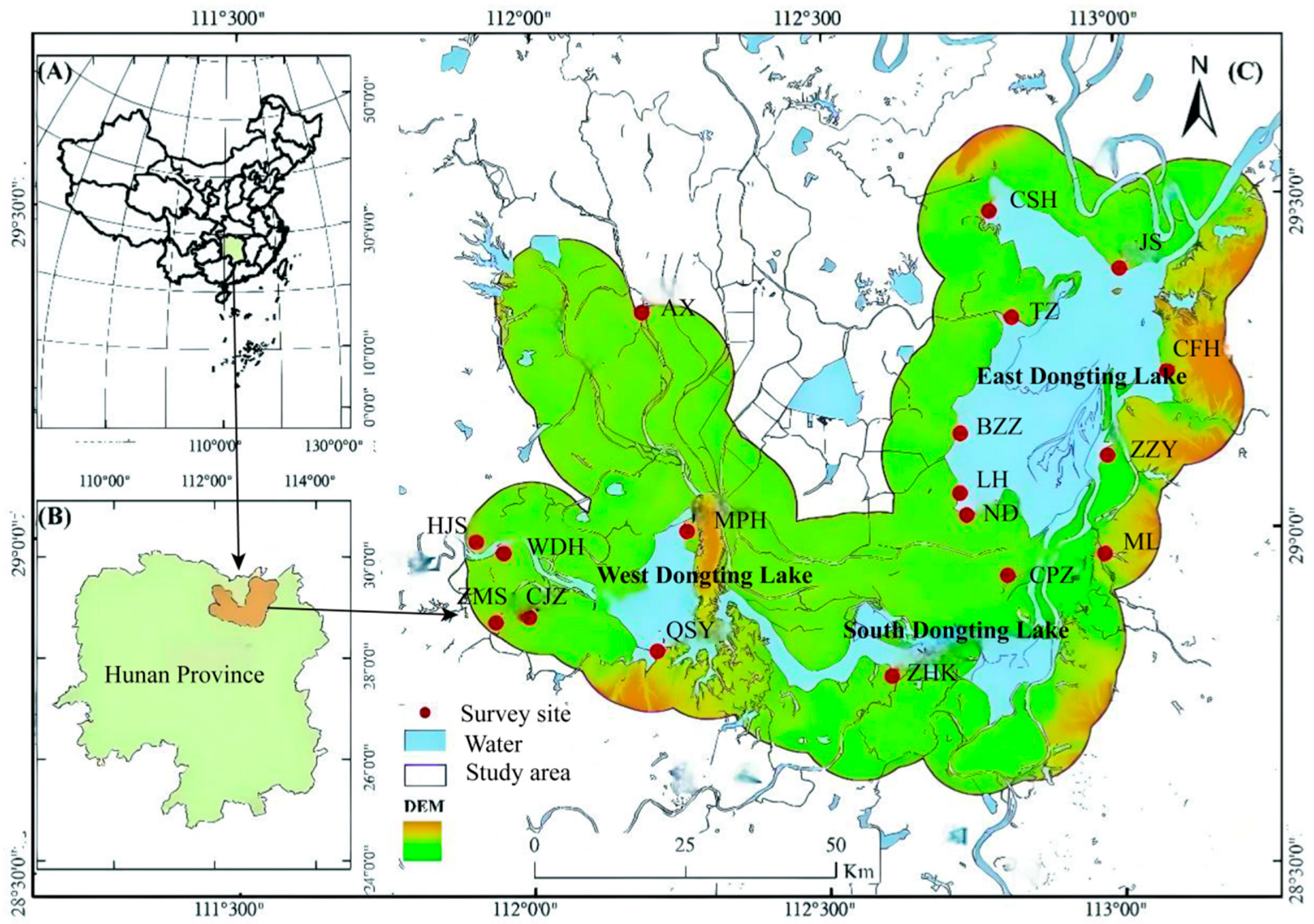
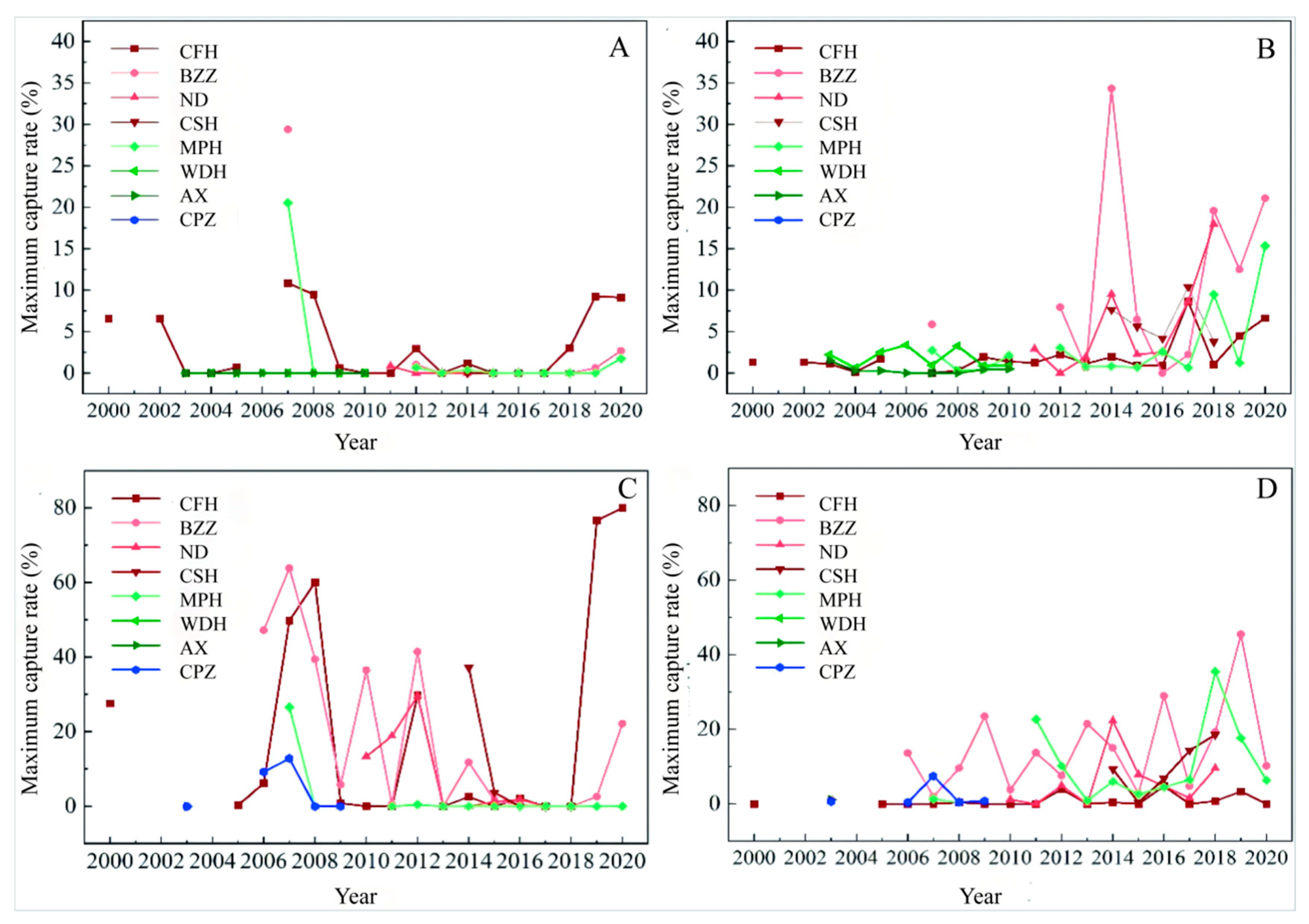
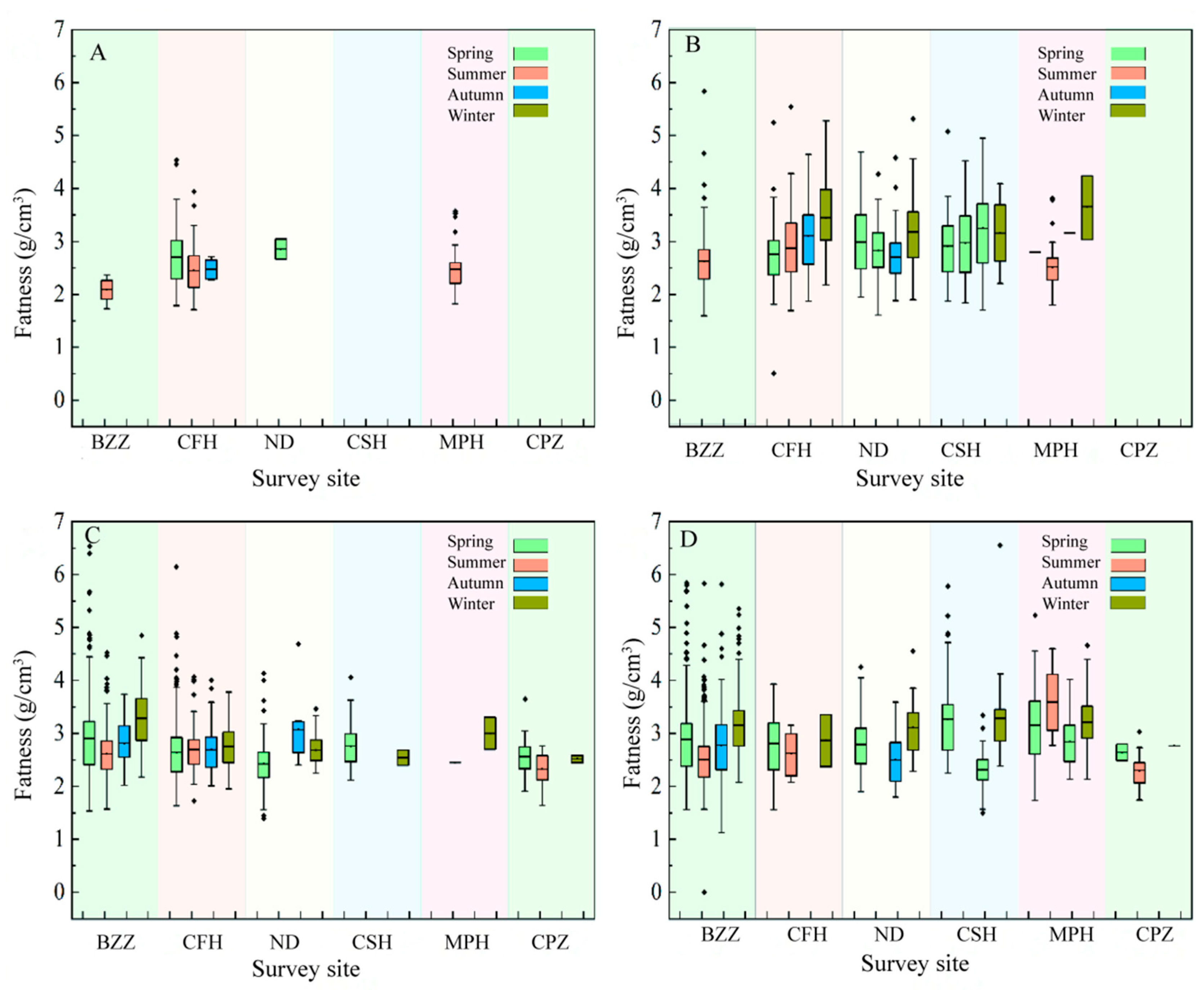
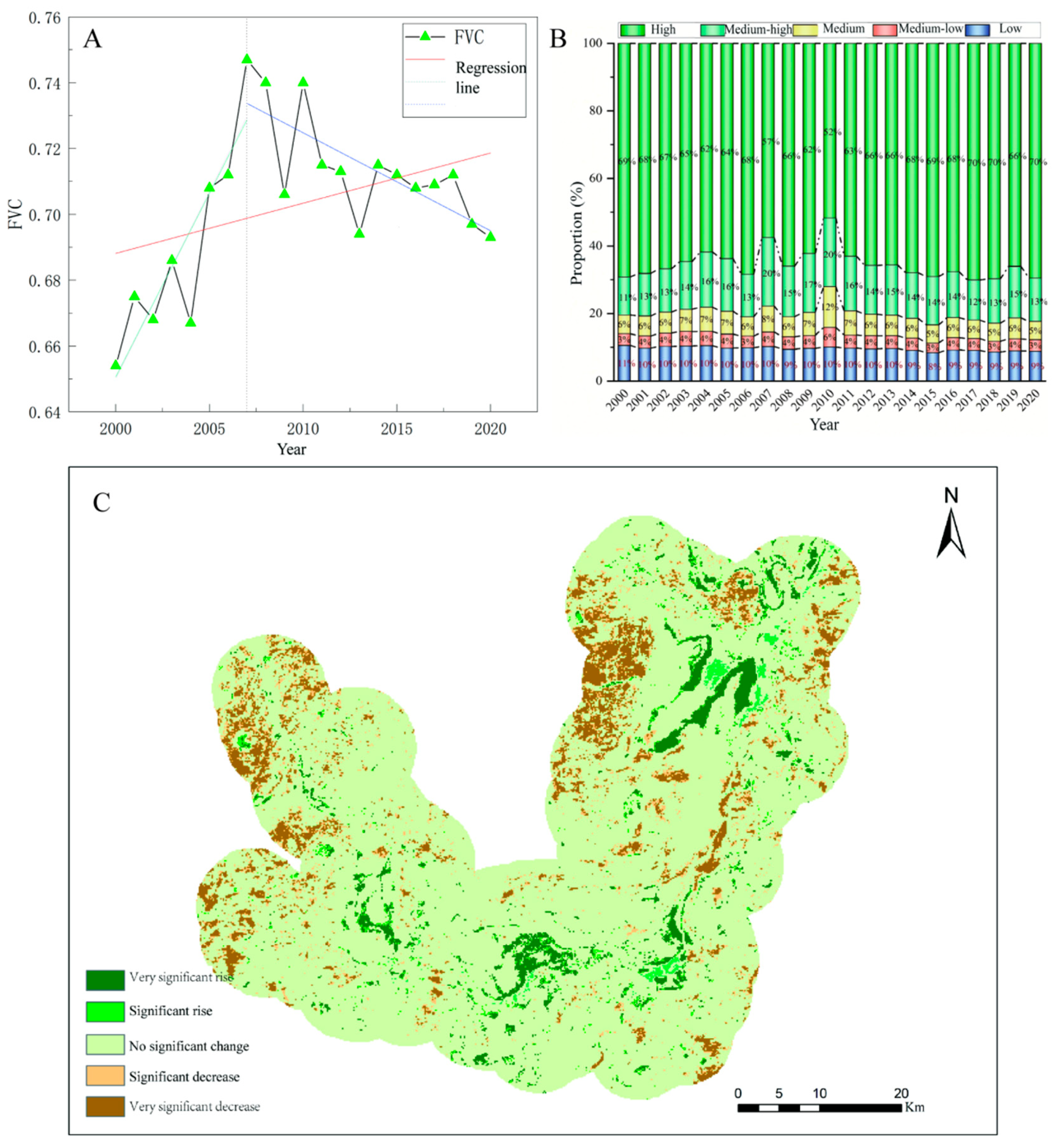
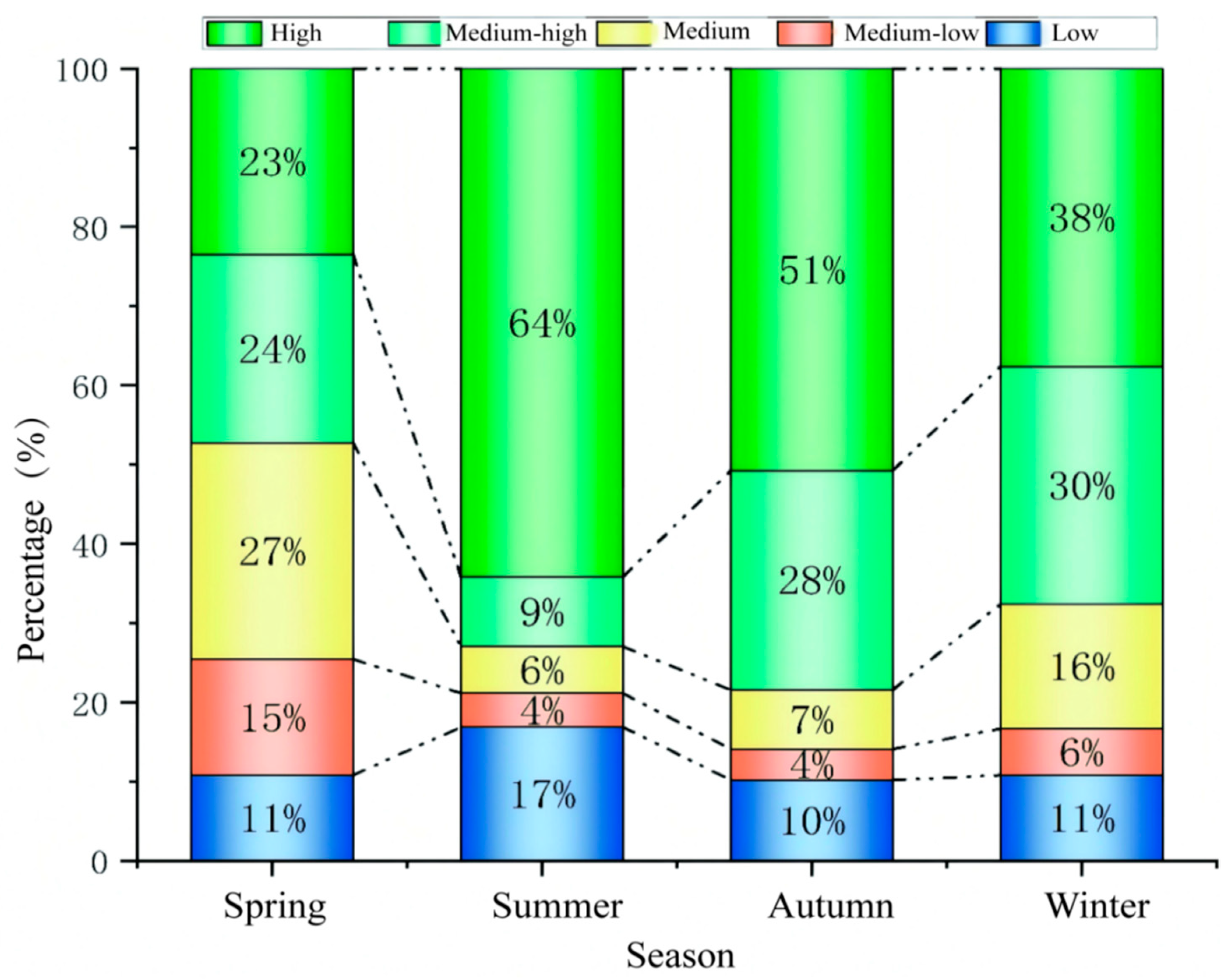
| Survey Site | Species | Low | Medium–Low | Medium | Medium–High | High | |||||
|---|---|---|---|---|---|---|---|---|---|---|---|
| r | p | r | p | r | p | r | p | r | p | ||
| BZZ | Microtus fortis | 0.464 | 0.70 | 0.349 | 0.185 | 0.335 | 0.205 | 0.502 | 0.047 | −0.468 | 0.607 |
| Apodemus agrarius | −0.538 | 0.032 | −0.412 | 0.113 | −0.353 | 0.179 | −0.277 | 0.299 | 0.378 | 0.149 | |
| CFH | Microtus fortis | −0.181 | 0.444 | −0.191 | 0.420 | −0.147 | 0.536 | 0.026 | 0.912 | 0.062 | 0.796 |
| Apodemus agrarius | −0.513 | 0.021 | −0.246 | 0.295 | −0.242 | 0.304 | −0.323 | 0.164 | 0.386 | 0.093 | |
| Survey Site | Species | Season | Low | Medium–Low | Medium | Medium–High | High | |||||
|---|---|---|---|---|---|---|---|---|---|---|---|---|
| r | p | r | p | r | p | r | p | r | p | |||
| BZZ | Microtus fortis | Spring | −0.573 | 0.007 | −0.276 | 0.227 | −0.158 | 0.494 | −0.113 | 0.626 | 0.263 | 0.250 |
| Summer | 0.052 | 0.823 | 0.093 | 0.688 | 0.169 | 0.464 | 0.271 | 0.234 | −0.231 | 0.313 | ||
| Autumn | −0.205 | 0.570 | −0.864 | 0.001 | −0.894 | 0.000 | −0.834 | 0.003 | 0.752 | 0.012 | ||
| Winter | −0.069 | 0.766 | 0.039 | 0.867 | 0.121 | 0.602 | 0.161 | 0.485 | −0.123 | 0.595 | ||
| Apodemus agrarius | Spring | −0.187 | 0.417 | 0.072 | 0.757 | 0.164 | 0.478 | 0.098 | 0.673 | −0.052 | 0.822 | |
| Summer | −0.185 | 0.421 | −0.074 | 0.749 | −0.063 | 0.785 | −0.052 | 0.824 | 0.085 | 0.715 | ||
| Autumn | 0.116 | 0.117 | 0.150 | 0.517 | 0.133 | 0.564 | 0.283 | 0.214 | −0.162 | 0.483 | ||
| Winter | 0.019 | 0.935 | 0.064 | 0.782 | 0.016 | 0.945 | 0.188 | 0.413 | −0.104 | 0.655 | ||
| CFH | Microtus fortis | Spring | −0.353 | 0.117 | −0.230 | 0.315 | −0.189 | 0.411 | 0.029 | 0.899 | 0.145 | 0.532 |
| Summer | −0.272 | 0.233 | −0.054 | 0.817 | 0.046 | 0.843 | −0.012 | 0.958 | 0.017 | 0.941 | ||
| Autumn | 0.006 | 0.981 | 0.308 | 0.175 | 0.329 | 0.145 | 0.546 | 0.010 | −0.391 | 0.079 | ||
| Winter | −0.239 | 0.298 | −0.060 | 0.797 | −0.058 | 0.802 | 0.078 | 0.736 | 0.065 | 0.778 | ||
| Apodemus agrarius | Spring | 0.408 | 0.066 | 0.342 | 0.129 | 0.369 | 0.100 | 0.335 | 0.137 | −0.464 | 0.034 | |
| Summer | −0.065 | 0.781 | 0.185 | 0.421 | 0.161 | 0.486 | 0.031 | 0.894 | −0.028 | 0.904 | ||
| Autumn | −0.120 | 0.606 | −0.144 | 0.534 | −0.174 | 0.450 | 0.058 | 0.804 | 0.088 | 0.704 | ||
| Winter | −0.239 | 0.310 | −0.065 | 0.785 | −0.053 | 0.823 | 0.082 | 0.732 | 0.012 | 0.960 | ||
Disclaimer/Publisher’s Note: The statements, opinions and data contained in all publications are solely those of the individual author(s) and contributor(s) and not of MDPI and/or the editor(s). MDPI and/or the editor(s) disclaim responsibility for any injury to people or property resulting from any ideas, methods, instructions or products referred to in the content. |
© 2025 by the authors. Licensee MDPI, Basel, Switzerland. This article is an open access article distributed under the terms and conditions of the Creative Commons Attribution (CC BY) license (https://creativecommons.org/licenses/by/4.0/).
Share and Cite
Huang, T.; Tang, Y.; Sun, Y.; Zhang, M.; Zhang, C.; Zhao, Y.; Nan, X.; Hu, Z.; Xu, Z. Effects of Vegetation Cover on Community Structure of Rodents Based on Long Time Series from Dongting Lake, China. Biology 2025, 14, 867. https://doi.org/10.3390/biology14070867
Huang T, Tang Y, Sun Y, Zhang M, Zhang C, Zhao Y, Nan X, Hu Z, Xu Z. Effects of Vegetation Cover on Community Structure of Rodents Based on Long Time Series from Dongting Lake, China. Biology. 2025; 14(7):867. https://doi.org/10.3390/biology14070867
Chicago/Turabian StyleHuang, Tian, Yongcheng Tang, Yuwen Sun, Meiwen Zhang, Chen Zhang, Yunlin Zhao, Xiaoning Nan, Zhiyuan Hu, and Zhenggang Xu. 2025. "Effects of Vegetation Cover on Community Structure of Rodents Based on Long Time Series from Dongting Lake, China" Biology 14, no. 7: 867. https://doi.org/10.3390/biology14070867
APA StyleHuang, T., Tang, Y., Sun, Y., Zhang, M., Zhang, C., Zhao, Y., Nan, X., Hu, Z., & Xu, Z. (2025). Effects of Vegetation Cover on Community Structure of Rodents Based on Long Time Series from Dongting Lake, China. Biology, 14(7), 867. https://doi.org/10.3390/biology14070867







